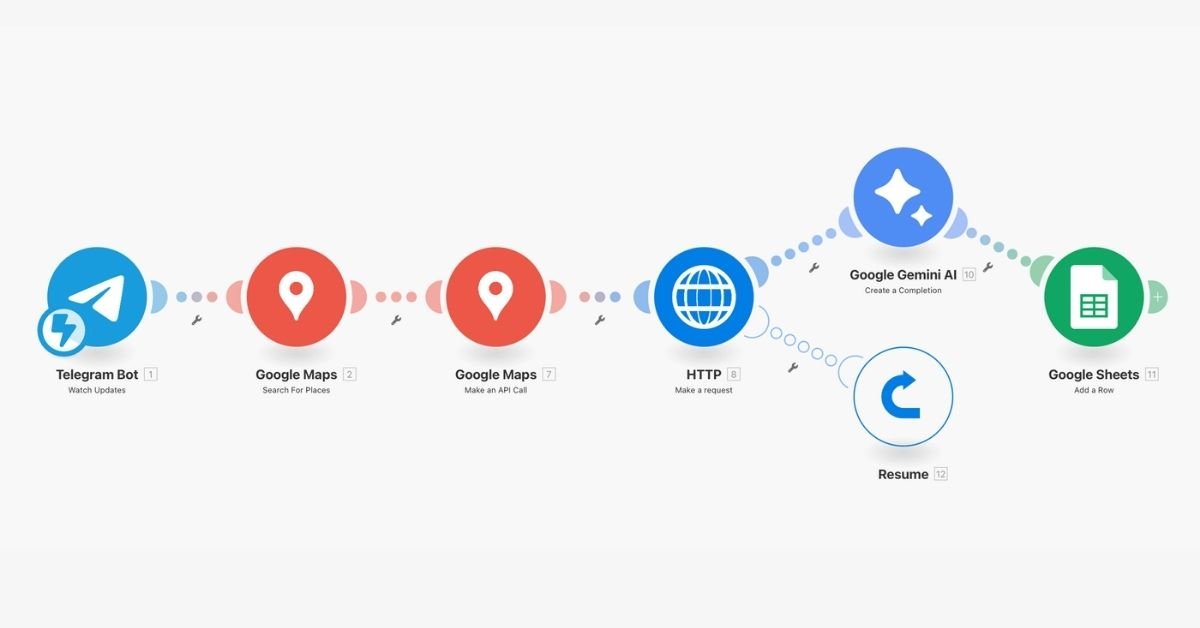Manually researching leads can be a massive time sink for sales teams — especially when they’re working with local business targets. One of my clients was spending 3–4 hours per lead batch identifying potential businesses, visiting websites, and taking notes in spreadsheets.
They needed a faster, smarter way to generate and qualify leads — without investing in expensive tools. That’s when I introduced them to an AI-powered automation system built using Make.com, Google Maps API, Gemini AI, and Google Sheets — with input coming in via a simple Telegram bot.

Client Background
During a routine check-in, the client — a growing B2B service provider — shared a bottleneck that was slowing down their sales team. They were manually searching for businesses in target areas (like “Auckland”), visiting each company’s website, and trying to decide whether it was a good fit for outreach.
This research process was repetitive and time-consuming, with inconsistent results. Hiring additional staff or investing in a high-end CRM tool wasn’t a viable option at the time, so they needed a lean and effective alternative that could scale as they grew.
The Problem
Here’s what their pre-automation lead generation workflow looked like:
🔍 Search manually on Google for businesses by location and category
🌐 Visit each business’s website (if available)
🧠 Manually judge whether the business was a good fit
🗂️ Copy relevant details into spreadsheets
⏳ Spend 3–4 hours compiling a single list of leads
This manual process not only drained time but also left room for inconsistency, missed opportunities, and duplicated effort across the sales team.
The Automation Workflow
To streamline their lead generation, I created a custom end-to-end automation system using Make.com, powered by AI and integrated with a few simple tools.
1. Telegram Bot Input
The workflow starts with a Telegram bot. A sales team member simply types a location like “Auckland” or “Sydney” into the chat. This keeps the system lightweight and mobile-friendly.
2. Google Maps API Lookup
Once the location is submitted, Make.com uses the Google Maps API to search for businesses in that area based on predefined industry categories (e.g., cafes, gyms, digital agencies).
It retrieves basic data like:
Business name
Location
Website (if available)
3. Website Screening with Gemini AI
For every business that has a website, Gemini AI steps in. The AI reads and analyzes the website content, scanning for relevance to the client’s ideal customer profile.
It evaluates things like:
Keywords and services mentioned
Business focus and offerings
Whether the company is a potential match
If the website content aligns with the target audience, it gets flagged as a qualified lead.
4. Results Saved to Google Sheets
The final list is saved in Google Sheets with the following structured information:
Business name
Location
Website URL
Qualification tag (e.g., “Prospect: Yes” or “No”)
Notes if the website is missing or incomplete
This gives the sales team a clean, organized, and pre-qualified list of leads they can immediately act on.
The Results
The difference was immediate and powerful:
⏱️ Time Saved: What used to take 3–4 hours now takes just a few minutes
🎯 Improved Accuracy: Leads are better aligned with the client’s target market
💰 Low Cost: No paid lead generation platforms or scraping services required
📈 Scalable Workflow: The system can handle any location or industry with minimal adjustment
The sales team now works from a pre-vetted lead list — helping them spend more time closing deals and less time hunting for contacts.
Tools Used
Make.com – for building and managing the workflow
Telegram Bot – for simple and fast input
Google Maps API – to locate local businesses by keyword and location
Gemini AI – to analyze website content and qualify leads
Google Sheets – to store and share the results in real time
Final Thoughts
This project shows how combining AI with automation tools can completely change how a sales team works — cutting hours of research down to minutes.
If your team still spends valuable time manually building lead lists, a solution like this could help you scale smarter, qualify faster, and focus on closing — all without investing in expensive tools or platforms.

